I always think it’s funny that it takes me an hour, or 1,300 words in this case, to teach someone how to have a 7-minute conversation about their business. But trust me, it only takes a few minutes once you get into the routine. Without it, I wouldn’t have been able to review about 100 different companies when I was looking to invest in a new venture.
More importantly, when I was running five different profit centers at one time, the concepts of the 7-minute conversation displayed in a worksheet became my security blanket.
In order to frame the 7-minute conversation, I created the "Home Run Line Up" of financial calculations because it “touches all the bases.” The calculations I chose use numbers from the Income Statement, Balance Sheet, and the Cash Flow Statement, giving you a well-rounded view of any business.
In just 7 minutes per month, you can get a complete picture of any company’s financial position using this framework. If any of these elements are alarming, you quickly know where to look to find the problem. Similarly, if the elements look good, you just keep moving forward with trying to provide the best service possible to your clients.
Here is what the completed Home Run Line Up Worksheet would look like for a sample company. As you can see, there are plenty of problems for the management team to address. But this is where the magic of the Home Run Line Up kicks in. As you read about each element, imagine you are having a conversation with your client about how to improve their company. You’ll find that the analysis is quick and very thorough.
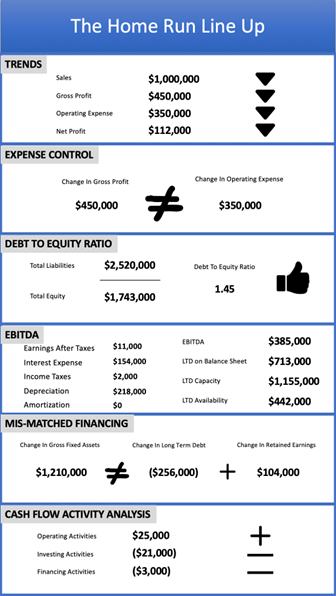
The Home Run Line Up
Let’s break down each of the six components of the Home Run Line Up.
1. Trends
Over a period of five years, the sample company’s
- Sales were down by $1,000,000
- Gross profit declined by $450,000
- Operating expenses decreased by $350,000
- Net profit had plummeted from $112,000 to just $11,000 or about $100,000
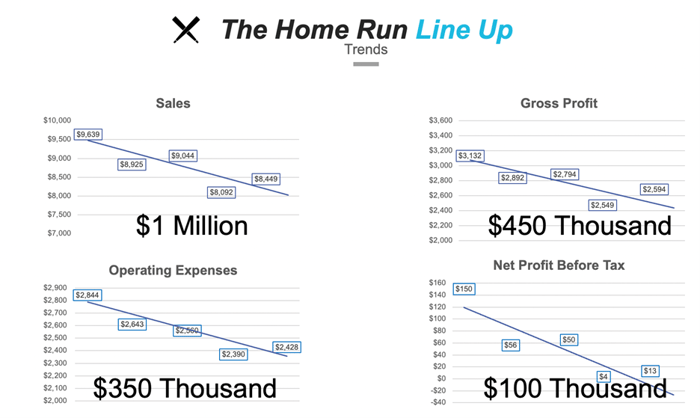
At first glance, this company is not in a good position. Although the company may have cut operating expenses to maintain its net profit, it needs a two-pronged approach to restore its former level of profitability. The two things that the company needs to focus on are sales and operating expenses.
First, the company has to work on increasing its sales. Sales drive the train, and this one is slowing down rapidly. Second, the company must continue cutting its operating expenses to be more in line with the decline in gross profit if it wants to recapture net profit.
2. Expense Control
The second element of the Home Run Line Up is expense control. We can see that the company has started to reduce its operating expenses which is the right move in this case. However, this reduction doesn’t match the decrease in gross profit. The change in gross profit during the 5 years is $450,000. Whereas the change in operating expenses is $350,000. This change should be equal if the company doesn’t want to compromise on its net profit.
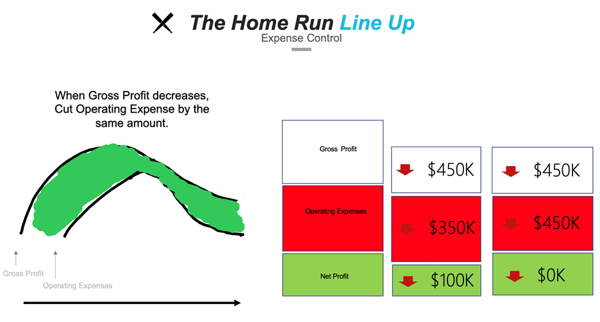 Though the company has reduced its operating expenses, it is still spending $100,000 extra as compared to its gross profit. So, the simple solution here is that you should cut operating expenses by another $100,000 to improve your net profit.
Though the company has reduced its operating expenses, it is still spending $100,000 extra as compared to its gross profit. So, the simple solution here is that you should cut operating expenses by another $100,000 to improve your net profit.
3. Debt to Equity Ratio
From your banker’s point of view, the ideal debt to equity ratio for a business is 2.5 or less. A ratio lower than 3.0 is good as it shows less risk to the bank because the owner has “skin in the game.” The debt-to-equity ratio of our sample company is 1.45. What does that indicate?

As I mentioned any ratio of less than 3 is good. So, it seems our sample company is looking pretty good. Lenders and investors can trust this company when making a business decision because the owners have been very responsible when using debt.
Managing your debt-to-equity ratio is crucial because lending should be an enhancement to your operation. You use debt to grow, not just survive. That’s what gets owners in trouble. They take on too much debt and their cash gets eaten up by interest payments.
So, as a business owner, if you think that you will be needing a loan the next year to hit your growth goal, keep this number in mind. You’ll need it to be at a 2.5 or lower. On the contrary, if you don’t need a loan, the number doesn’t mean as much. You can allow it to creep higher as you try to minimize your income tax obligations by reducing your net profit.
4. EBITDA / LTD Availability
EBITDA (earnings before interest, taxes, depreciation, and amortization) is the fourth element of our Home Run Line Up worksheet, and it is simply another term for cash flow. According to the calculations, the sample company is in a lot better position in terms of EBITDA, when we compare it to net profit.
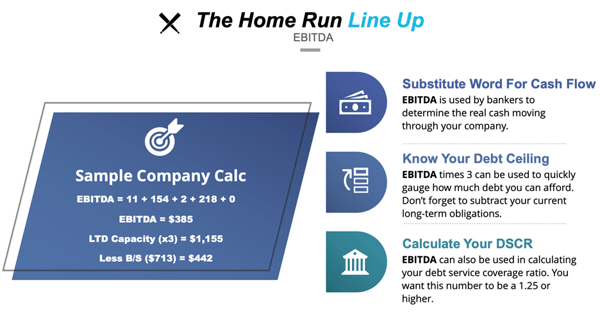 One of the ways a business owner can use EBITDA is to determine the long-term debt (LTD) capacity of their company. The LTD capacity of our sample company is $1,155,000, which is EBITDA times three. We have already borrowed $713,000, so that leaves a remaining availability of $442,000.
One of the ways a business owner can use EBITDA is to determine the long-term debt (LTD) capacity of their company. The LTD capacity of our sample company is $1,155,000, which is EBITDA times three. We have already borrowed $713,000, so that leaves a remaining availability of $442,000.
Knowing how much you can borrow is a good thing, especially if you want to buy a piece of equipment in the future.
5. Mis-Matched Financing
Mis-matched financing is the silent killer of businesses, and it happens without you even realizing it. Our sample company has fallen victim to buying something with the wrong type of credit product.
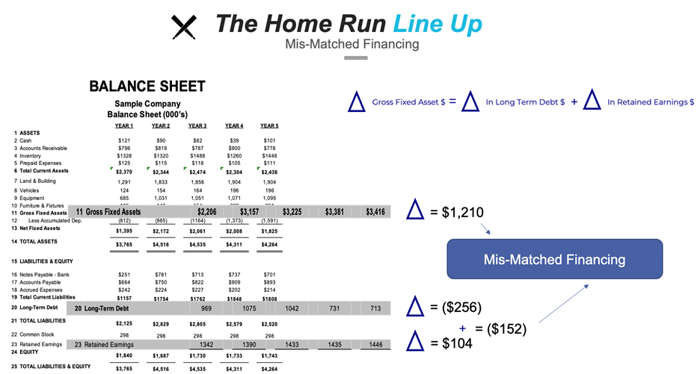
The change in gross fixed assets (GFA) is not equal to the sum of the change in long-term debt plus the change in retained earnings. The result means the company is most likely using short-term debt to finance its long-term equipment needs.
In other words, our sample company is probably paying too much in interest, but it’s fixable. Our sample company just needs to contact a banker to help restructure the loans on some of their past purchases.
6. Cash Flow Activity Pattern
The last element of the Home Run Line Up is the cash flow activity pattern. The management probably already knows this, but we determined that this company is experiencing some cash flow issues. The company is selling its assets to cover its day-to-day expenses and pay off its debt.
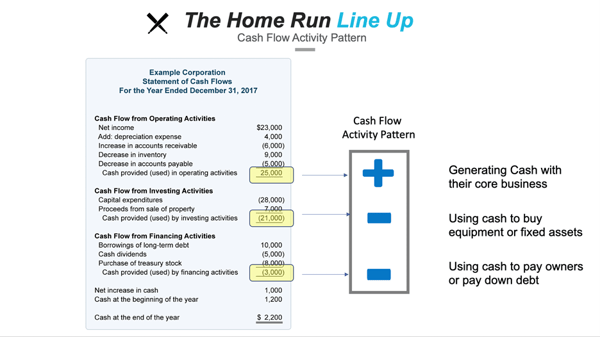
This kind of approach leads right to a shutdown of the business. A company buys assets to generate revenue. When the same assets are sold to meet the operating expenses requirement, they reduce their ability to generate revenue from their operation. We call this the death spiral.
Benefits of Home Run Line Up Worksheet
So, did you see how quickly we identified the major problems in our sample company? Moreover, we easily got to know the root causes of these problems as well. It becomes quite easy for a business owner or the financial advisor to solve the issues when they know the root cause of the problem, and the Home Run Line Up touches all the bases!
The Home Run Line Up Worksheet can help you look at the financial health of any business in minutes. No one wants to devote the hours it can take to understand their business’s financial metrics. But everyone can benefit from seeing their business through the eyes of the financials in just a few minutes per month. After using this technique for the first time, you will have a better understanding of your company’s true financial position!
Now give it a try yourself and you will be on The Clear Path to Cash.
Speaking of, if you like to swim at the deep end of the financial pool, as I do, here are three options for you.
1. Join me for Cash Flow Management Essentials offered by Woodard. This Power Day will be offered on Friday, May 20th.
2. Check out my book called Don’t Be A D.U.M.B. Business Owner to learn 8 steps to maximizing cash in your business and better yet, build a lifestyle-friendly business.
3. Read my book The 7 Minute Conversation for an in-depth look into how to implement this technique in your practice.
.png?width=150&height=63&name=TWRlogo-regmark_blueblack%20(1).png)
.png)










Do you have questions about this article? Email us and let us know > info@woodard.com
Comments: